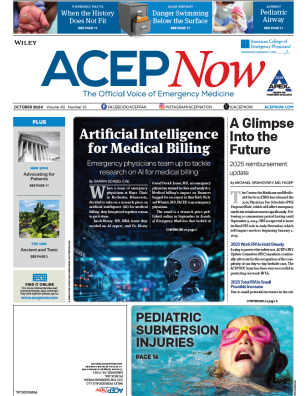Acute pancreatitis remains an important diagnosis in emergency medicine, accounting for more than 220,000 hospital admissions a year.1-4 The frequency of hospitalizations has increased 100% in the last 2 decades and is predicted to continue to increase, likely related to the growing obesity epidemic.3,5,6 Emergency physicians are often challenged with the diagnosis of acute pancreatitis, and this article seeks to offer evidence-based guidelines for the diagnosis and management of this disease.
Epidemiology
Acute pancreatitis can be separated into mild and severe pancreatitis.
Severe pancreatitis is defined by the presence of local complications (pseudocysts, necrosis, abscess) or organ failure (renal failure, pulmonary insufficiency, shock).1,4,7,8 Mild pancreatitis occurs in about 80% of patients, is self-limited, and resolves without complication. The remaining 20% of patients develop severe pancreatitis.2,8,9
The mortality for pancreatitis overall is 5%.1,3 The mortality of severe pancreatitis is 14%-25%.2,8,10 The presence of multiorgan failure increases this value to 47%.1,3,10 About half of the deaths occur within 2 weeks as the result of multiorgan failure, and the remainder occur later from complications of infection.10
Pathophysiology
Acute pancreatitis is caused by inappropriate activation of trypsin. This leads to pancreatic autodigestion and the activation of a variety of other digestive enzymes. Local inflammatory mediators are released, leading to distant extra-pancreatic organ dysfunction, including shock, acute respiratory distress syndrome (ARDS), and renal failure.1,2,8
The inciting factor that leads to inappropriate trypsin activation varies according to the etiology of acute pancreatitis. Gallstone pancreatitis develops when a gallstone lodges in either the pancreatic or common bile duct, leading to increased intraductal pressure, bile reflux, and trypsin activation.8,9
Idiopathic pancreatitis is the third-leading cause of acute pancreatitis (after gallstone and alcohol disease) and is increasingly thought to be from biliary microlithiasis.3,8,10
Other etiologies of acute pancreatitis include hypertriglyceridemia (serum levels greater than 1,000 mg/dL), drug-induced pancreatitis, trauma, postendoscopic retrograde cholangiopancreatography (ERCP), pancreas divisum, tumor, and infection.8,10,11
Questionnaire Available Online
This educational activity should take approximately 1 hour to complete. The CME test and evaluation form are located online at www.ACEP.org/focuson.
The participant should, in order, review the learning objectives, read the article, and complete the CME post-test/evaluation form to receive 1 ACEP Category 1 credit and 1 AMA/PRA Category 1 credit. You will be able to print your CME certificate immediately.




No Responses to “Acute Pancreatitis”